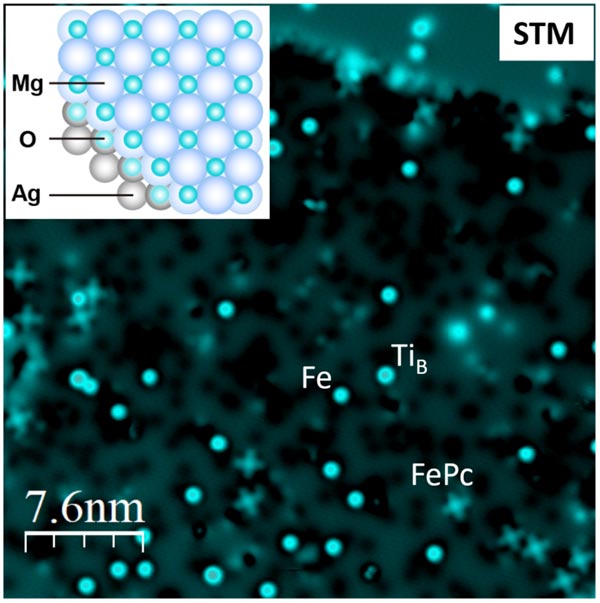ESR-STM on single molecules and molecule-based structures

STM image of iron phthalocyanine (FePc) molecules, iron (Fe) atoms, and titanium (Ti) atoms co-deposited on 2 monolayers of magnesium oxide (MgO) surface atop a silver substrate. Well-isolated FePc molecules and naturally formed FePc dimers are abundant.
Credit: Institute for Basic Science
Engineering quantum states of molecules on surfaces.
Scaling down information devices to the atomic scale has brought the interest of using individual spins as a basic unit for data storage. This requires precise detection and control of spin states and a better understanding of spin-spin interactions.
For the first time ever, scientists at the IBS Center for Quantum Nanoscience at Ewha Womans University (QNS) have imaged the spin of an individual molecule using electron spin resonance in a scanning tunneling microscope. This achievement, published this month in Nature Chemistry, harnessed the power of synthetic chemistry to control the electron spin of a molecule.
A scanning tunneling microscope (STM) has the ability to see exact atomic structures, atom by atom, at a level that is not possible with other techniques. This study uses an electric microwave applied to the STM tip to drive electron spin resonance (ESR) on single molecules and investigate the magnetic interaction between two molecules using this technique.
“Employing single molecules in atomic-scale quantum-control studies is always of high interest and importance. This work sheds light on some intriguing magnetic interactions between non-localized spins, which is crucial for developing molecule-based spintronic devices,” says the paper’s first author, Dr. Xue Zhang.
Fe, Ti atoms, and FePc molecules were co-deposited on the surface of a thin magnesium oxide film grown on a silver substrate. They were then imaged and probed using an STM equipped with ESR capabilities. This work has extended the ESR experimental platform from single atoms to a much broader class of matter – magnetic molecules, which brings many more possibilities to perform quantum control on single magnetic molecules.
Electron spin resonance is widely employed in biology and chemistry to determine the structure of unknown molecules and to measure the dynamic properties of spins in these molecules. ESR is a cousin of magnetic resonance imaging (MRI) that most people are familiar with from hospital visits. ESR is also an essential tool in the emerging research field of quantum-coherent nanoscience, where the quantum properties of spins are utilized for quantum computation and quantum information science.
“It is impressive to see that the intermolecular interaction can be investigated with an energy resolution in the nano-electron volt precision. Certainly, we should explore more unknowns with this fantastic ESR-STM technique,” says Yu Wang of QNS.
Journal: Nature Chemistry
DOI: 10.1038/s41557-021-00827-7
Method of Research: Experimental study
Subject of Research: Not applicable
Article Title: Electron Spin Resonance of Single Molecules and Magnetic Interaction through Ligands
Article Publication Date: 11-Nov-2021
Media Contact
William Suh
Institute for Basic Science
willisuh@ibs.re.kr
Office: 82-010-379-37830
All latest news from the category: Life Sciences and Chemistry
Articles and reports from the Life Sciences and chemistry area deal with applied and basic research into modern biology, chemistry and human medicine.
Valuable information can be found on a range of life sciences fields including bacteriology, biochemistry, bionics, bioinformatics, biophysics, biotechnology, genetics, geobotany, human biology, marine biology, microbiology, molecular biology, cellular biology, zoology, bioinorganic chemistry, microchemistry and environmental chemistry.
Newest articles

A universal framework for spatial biology
SpatialData is a freely accessible tool to unify and integrate data from different omics technologies accounting for spatial information, which can provide holistic insights into health and disease. Biological processes…

How complex biological processes arise
A $20 million grant from the U.S. National Science Foundation (NSF) will support the establishment and operation of the National Synthesis Center for Emergence in the Molecular and Cellular Sciences (NCEMS) at…

Airborne single-photon lidar system achieves high-resolution 3D imaging
Compact, low-power system opens doors for photon-efficient drone and satellite-based environmental monitoring and mapping. Researchers have developed a compact and lightweight single-photon airborne lidar system that can acquire high-resolution 3D…





















